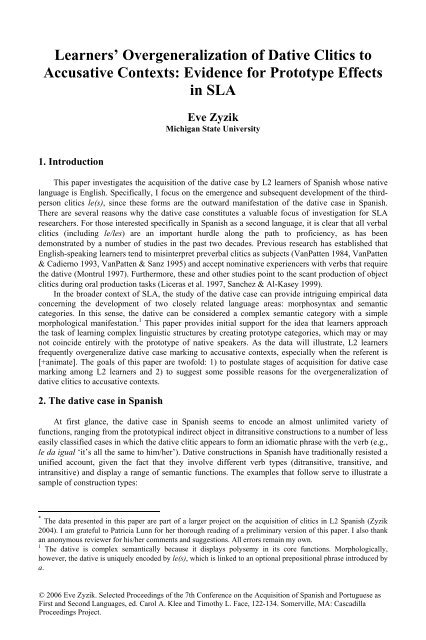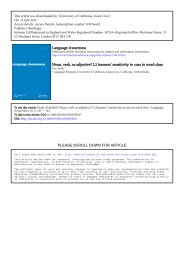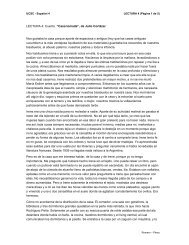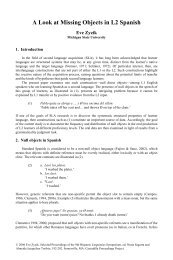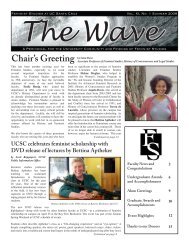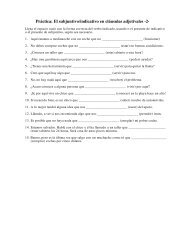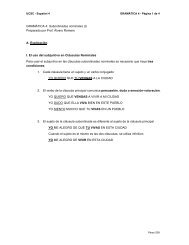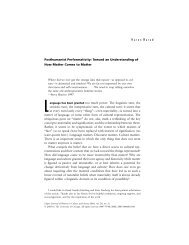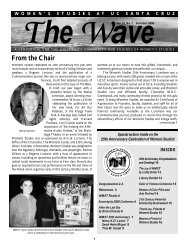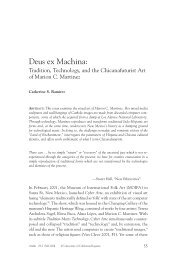Learners' Overgeneralization of Dative Clitics to - Cascadilla ...
Learners' Overgeneralization of Dative Clitics to - Cascadilla ...
Learners' Overgeneralization of Dative Clitics to - Cascadilla ...
Create successful ePaper yourself
Turn your PDF publications into a flip-book with our unique Google optimized e-Paper software.
Learners’ <strong>Overgeneralization</strong> <strong>of</strong> <strong>Dative</strong> <strong>Clitics</strong> <strong>to</strong>Accusative Contexts: Evidence for Pro<strong>to</strong>type Effectsin SLAEve ZyzikMichigan State University1. IntroductionThis paper investigates the acquisition <strong>of</strong> the dative case by L2 learners <strong>of</strong> Spanish whose nativelanguage is English. Specifically, I focus on the emergence and subsequent development <strong>of</strong> the thirdpersonclitics le(s), since these forms are the outward manifestation <strong>of</strong> the dative case in Spanish.There are several reasons why the dative case constitutes a valuable focus <strong>of</strong> investigation for SLAresearchers. For those interested specifically in Spanish as a second language, it is clear that all verbalclitics (including le/les) are an important hurdle along the path <strong>to</strong> pr<strong>of</strong>iciency, as has beendemonstrated by a number <strong>of</strong> studies in the past two decades. Previous research has established thatEnglish-speaking learners tend <strong>to</strong> misinterpret preverbal clitics as subjects (VanPatten 1984, VanPatten& Cadierno 1993, VanPatten & Sanz 1995) and accept nominative experiencers with verbs that requirethe dative (Montrul 1997). Furthermore, these and other studies point <strong>to</strong> the scant production <strong>of</strong> objectclitics during oral production tasks (Liceras et al. 1997, Sanchez & Al-Kasey 1999).In the broader context <strong>of</strong> SLA, the study <strong>of</strong> the dative case can provide intriguing empirical dataconcerning the development <strong>of</strong> two closely related language areas: morphosyntax and semanticcategories. In this sense, the dative can be considered a complex semantic category with a simplemorphological manifestation. 1 This paper provides initial support for the idea that learners approachthe task <strong>of</strong> learning complex linguistic structures by creating pro<strong>to</strong>type categories, which may or maynot coincide entirely with the pro<strong>to</strong>type <strong>of</strong> native speakers. As the data will illustrate, L2 learnersfrequently overgeneralize dative case marking <strong>to</strong> accusative contexts, especially when the referent is[+animate]. The goals <strong>of</strong> this paper are tw<strong>of</strong>old: 1) <strong>to</strong> postulate stages <strong>of</strong> acquisition for dative casemarking among L2 learners and 2) <strong>to</strong> suggest some possible reasons for the overgeneralization <strong>of</strong>dative clitics <strong>to</strong> accusative contexts.2. The dative case in SpanishAt first glance, the dative case in Spanish seems <strong>to</strong> encode an almost unlimited variety <strong>of</strong>functions, ranging from the pro<strong>to</strong>typical indirect object in ditransitive constructions <strong>to</strong> a number <strong>of</strong> lesseasily classified cases in which the dative clitic appears <strong>to</strong> form an idiomatic phrase with the verb (e.g.,le da igual ‘it’s all the same <strong>to</strong> him/her’). <strong>Dative</strong> constructions in Spanish have traditionally resisted aunified account, given the fact that they involve different verb types (ditransitive, transitive, andintransitive) and display a range <strong>of</strong> semantic functions. The examples that follow serve <strong>to</strong> illustrate asample <strong>of</strong> construction types:* The data presented in this paper are part <strong>of</strong> a larger project on the acquisition <strong>of</strong> clitics in L2 Spanish (Zyzik2004). I am grateful <strong>to</strong> Patricia Lunn for her thorough reading <strong>of</strong> a preliminary version <strong>of</strong> this paper. I also thankan anonymous reviewer for his/her comments and suggestions. All errors remain my own.1 The dative is complex semantically because it displays polysemy in its core functions. Morphologically,however, the dative is uniquely encoded by le(s), which is linked <strong>to</strong> an optional prepositional phrase introduced bya.© 2006 Eve Zyzik. Selected Proceedings <strong>of</strong> the 7th Conference on the Acquisition <strong>of</strong> Spanish and Portuguese asFirst and Second Languages, ed. Carol A. Klee and Timothy L. Face, 122-134. Somerville, MA: <strong>Cascadilla</strong>Proceedings Project.
124interaction” (Maldonado 2002:26), is essential because it accounts for the use <strong>of</strong> the dative <strong>to</strong> signalpossession, and furthermore, demonstrates that inanimate objects can also be affected participants.This last point deserves further clarification. Although Spanish is a language in which inanimates canbe marked dative, corpus data indicate that the overwhelming majority <strong>of</strong> datives are [+animate] and[+human] (Silva-Corvalán 1984, Vázquez Rozas 1995). This correlation between animacy and dativecase is not coincidental, given the characterization <strong>of</strong> datives as active participants.3. Methodology3.1 ParticipantsThe participants were 50 L2 Spanish learners enrolled in a variety <strong>of</strong> courses at the University <strong>of</strong>California, Davis. Together, these 50 learners comprised four pr<strong>of</strong>iciency groups, based on theirinstitutional status and prior exposure <strong>to</strong> Spanish: beginning, intermediate, high intermediate, andadvanced. The criteria for each grouping are listed in Table 1.Pr<strong>of</strong>iciency group Number Course Enrollment Time AbroadBeginner 12 Spanish 3—end <strong>of</strong> 1 st year NoneIntermediate 12 Spanish 22—end <strong>of</strong> 2 nd year NoneHigh Intermediate 12 Spanish 100—end <strong>of</strong> 3 rd year 2-3 monthsAdvanced 14 any upper division course 1 yearTable 1: Participant pr<strong>of</strong>ilesThe group <strong>of</strong> 50 L2 learners included 38 females and 12 males, representing an age range from 17<strong>to</strong> 24, with an average age <strong>of</strong> 20.5. In addition <strong>to</strong> their institutional status, the participants wereaccepted for the study only after being screened for a number <strong>of</strong> background fac<strong>to</strong>rs: L1, study abroad,and formal instruction in other Romance languages. All participants were native English speakers whoreported English as the only language spoken in their household; none had formally studied anotherRomance language. The participants in the beginner and intermediate groups had studied Spanishexclusively in the U.S. setting. The high intermediate and advanced students had all studied abroad,with an important difference between the two groups: the former had been on short-term study abroadprograms (i.e., 3 months or less), whereas the latter group consisted solely <strong>of</strong> Spanish majors/minorswho had returned from an academic year abroad.3.2 TasksOral production data were gathered from the participants by means <strong>of</strong> four different elicitationprocedures: a picture book narration, a structured interview task, and two video narration tasks. Thefirst task, the s<strong>to</strong>rybook narration, was based on a popular children’s picture book: dePaola’s (1978)Pancakes for Breakfast. In order <strong>to</strong> assist them with the s<strong>to</strong>rybook task, the participants were givenfive minutes <strong>of</strong> planning time <strong>to</strong> look at the pictures and <strong>to</strong> consult a list <strong>of</strong> eighteen vocabulary items.The second task was a structured interview consisting <strong>of</strong> a series <strong>of</strong> comprehension questions related <strong>to</strong>the s<strong>to</strong>rybook. The questions were intended <strong>to</strong> establish a particular object as discourse <strong>to</strong>pic, whichwould then encourage learners <strong>to</strong> respond with an anaphoric clitic pronoun. This structured interviewformat has been used in previous research focusing on Spanish clitics (Sanz 1997, VanPatten & Sanz1995). The two remaining tasks involved a video narration procedure in which participants watchedtwo silent video clips that depicted a variety <strong>of</strong> two- and three-participant events. The participants weregiven a list <strong>of</strong> English-Spanish equivalents before viewing each video clip. The video clips wereshown twice and the participants were asked <strong>to</strong> narrate the events that were happening on the screenduring the second viewing (i.e., in real time). Data collection <strong>to</strong>ok place individually with eachparticipant during two half-hour sessions. The oral data were recorded, transcribed, and then analyzedwith specific attention paid <strong>to</strong> the use <strong>of</strong> the dative clitics le(s).
1264. Results4.1 Group <strong>to</strong>talsThe <strong>to</strong>tal number <strong>of</strong> dative clitics (le/les) produced by the 50 L2 learners was 309. These <strong>to</strong>kensare distributed disproportionately among the four pr<strong>of</strong>iciency levels; the beginning learners produced anegligible number <strong>of</strong> dative clitics, while the advanced learners outperformed all the remaining groupswith 143 <strong>to</strong>kens. The descriptive statistics for all four groups are presented below in Table 2.Beginner (A) Intermediate (B) High Intermediate (BC) Advanced (CD)Total <strong>to</strong>kens 5 68 93 143Mean .42 5.67 7.75 10.21SD .79 4.5 7.39 5.82Table 2: Descriptive statistics for dative clitic useResults from a one-way ANOVA show that there are significant differences among the fourgroups (F(3, 46) = 7.94, p < .001). A post-hoc Tukey test reveals significant differences between thebeginners and the three other groups (p < .001 for all three comparisons), as well as between theintermediate and advanced learners (p < .05). These results are presented in the <strong>to</strong>p row <strong>of</strong> Table 2(following standard statistical notation, a shared letter indicates that the difference between groupsfailed <strong>to</strong> reach significance).As shown in Table 2, the beginner group displayed minimal use <strong>of</strong> dative clitics. Due <strong>to</strong> the lownumber <strong>of</strong> <strong>to</strong>kens, a functional analysis for this group <strong>of</strong> learners would be questionable. Three <strong>of</strong> the<strong>to</strong>kens occurred in the context <strong>of</strong> gustar/encantar ‘like,’ one <strong>to</strong>ken <strong>of</strong> le appeared in a two-participantevent (besar ‘kiss’) and one learner used a dative clitic with the ditransitive dar ‘give.’It would be premature <strong>to</strong> draw any conclusions based on five <strong>to</strong>kens <strong>of</strong> use, but it is interestingthat all <strong>of</strong> these uses, with the exception <strong>of</strong> le besa ‘he kisses her,’ could be viewed as lexicalizedchunks. Clearly the verbs gustar and encantar are taught repeatedly in first-year language classes, andholophrastic utterances like me gusta and le gusta are commonly used by students at the beginninglevel. There is some evidence <strong>to</strong> indicate that the le gusta sequence is an unanalyzed chunk, such as thefact that learners rarely mark subject-verb agreement in these constructions (see example 8 below).This tendency is found in more experienced language learners as well. For the reader’s convenience,all samples <strong>of</strong> learner language from the corpus are marked for participant number (1-50) and task type(ST = s<strong>to</strong>rybook, SI = structured interview, V1/V2 = video narrations).(8) Porque le encanta los panqueques. (P7) (ST)‘Because he loves pancakes.’Table 3 presents the functional distribution for the remaining three groups <strong>of</strong> learners. Thecolumns are split in order <strong>to</strong> present the number <strong>of</strong> <strong>to</strong>kens in each semantic category (e.g., Recipient,Beneficiary) as well as the percentage <strong>of</strong> the <strong>to</strong>tal number <strong>of</strong> <strong>to</strong>kens produced by each group.Intermediate (68) High Intermediate (93) Advanced (143)Recipient 29 42.6% 37 40% 48 33.5%Source 0 0 4 4.3% 12 8.4%Experiencer 14 20.6% 13 14% 8 5.6%Beneficiary 5 7.4% 3 3.2% 7 4.9%Possessor 0 0 1 1% 0 0Patient (m.) 6 8.8% 25 26.8% 39 27.3%Patient (f.) 9 13.2% 10 10.7% 27 18.9%Other 5 7.4% 0 0 2 1.4%Table 3: Distributional analysisThe distributional analysis for the intermediate, high intermediate and advanced learners indicatesseveral interesting trends in the acquisition <strong>of</strong> the dative case. First, it is the Recipient function that
emains strong throughout all levels, accounting for a large proportion <strong>of</strong> all <strong>to</strong>kens <strong>of</strong> le(s). Theditransitive verb dar ‘give’ is the most frequently used in this category, but decir ‘tell,’ traer ‘bring,’and servir ‘serve’ are also found with some regularity (refer <strong>to</strong> example 9). The Source function, whichwas inexistent at the beginning and intermediate levels, emerges in the speech <strong>of</strong> some highintermediate learners, as illustrated in (10).(9) Ella come la cena y luego Pablo le sirve un café. (P19) (V1)‘She eats the dinner and later Pablo serves her a c<strong>of</strong>fee.’(10) Carmen va a bañar su perro Tico y le quita el collar. (P32) (V2)‘Carmen is going <strong>to</strong> bathe her dog Tico and she takes <strong>of</strong>f his collar.’With respect <strong>to</strong> the Experiencer role, the results indicate that this function appears early in theacquisition process. However, caution must be used in interpreting the results, given that many <strong>of</strong> these<strong>to</strong>kens <strong>of</strong> le(s) only superficially correspond <strong>to</strong> a dative experiencer. Learners from all pr<strong>of</strong>iciencygroups consistently employ the verb gustar with the appropriate dative clitic, but rarely does theutterance conform <strong>to</strong> the intransitive structure <strong>of</strong> Spanish. Consider the following examples fromintermediate and high intermediate learners:(11) Pero Camila no le gusta tirar su chaqueta en el armario. (P16) (V1)‘But Camila (nom.) doesn’t like <strong>to</strong> throw her jacket in the closet.’(12) Y el perri<strong>to</strong> le gusta la comida. (P28) (ST)‘And the dog (nom.) likes the food.’These examples provide further evidence for the hypothesis that le gusta is initially learned as achunk and that learners reinterpret the structure <strong>to</strong> match the transitive frame <strong>of</strong> their L1 (i.e.,nominative experiencer). Most learners, even at high intermediate and advanced levels, continue <strong>to</strong> usegustar according <strong>to</strong> English syntactic frames for the verb ‘<strong>to</strong> like.’ 3The Beneficiary function <strong>of</strong> the dative case accounts for a small percentage <strong>of</strong> le(s) usage at allthree pr<strong>of</strong>iciency levels. This could be a task effect in that there may not have been enough contexts inwhich <strong>to</strong> use this particular function <strong>of</strong> the dative. However, another possibility is that Englishspeakinglearners rely on prepositional phrases <strong>to</strong> signal an affected participant, as illustrated in (12).(13) Y Pablo pone la manta sobre Camila y le besa. (P13) (V1)‘And Pablo puts the blanket over Camila and kisses her (dat.).’Note how this intermediate learner chooses the prepositional phrase in the first clause (instead <strong>of</strong> lepone la manta) while making use <strong>of</strong> the dative in the two-participant event. The use <strong>of</strong> prepositionalphrases like [para + NP] and [sobre + NP] may partially account for the low incidence <strong>of</strong> theBeneficiary function in learner language.The use <strong>of</strong> le(s) <strong>to</strong> indicate possession was almost nonexistent in the corpus. In general, twotendencies can be observed in the context <strong>of</strong> whole/part relations: some learners rely on the use <strong>of</strong>possessive determiners (conforming <strong>to</strong> the L1 pattern) while others use the definite determiner and nocorresponding clitic <strong>to</strong> indicate the affected participant. The following examples illustrate bothtendencies:(14) Y empezó a secar el Tico con una <strong>to</strong>alla. Y seca su cabeza y su cuerpo. (P25) (V2)‘And she began <strong>to</strong> dry Tico with a <strong>to</strong>wel. And she dries his head and his body.’1273 This can only be confirmed when the learner uses the full NP and/or a plural subject. On the contrary, anutterance like le gusta el café makes it impossible <strong>to</strong> determine the status <strong>of</strong> the clitic pronoun in interlanguage. Itcould be an indication that the learner has appropriately used the dative experiencer construction, or that he/shehas simply reinterpreted le as subject (‘he likes c<strong>of</strong>fee’).
128(15) Ella usa un secador para secar el pelo, y las orejas, y el cuerpo. (P26) (V2)‘She uses a dryer <strong>to</strong> dry the hair, the ears, and the body.’These examples are representative <strong>of</strong> how the dative is absent from learner language in possessivecontexts, even among advanced learners who have spent an academic year abroad.4.2 Extension <strong>of</strong> the dative <strong>to</strong> accusative contextsThe next two categories in the distributional analysis (masculine and feminine patients) point <strong>to</strong> anovergeneralization <strong>of</strong> the dative <strong>to</strong> accusative contexts. This trend begins at the intermediate level andshows a steady increase as learners gain exposure <strong>to</strong> the target language. A particularly interesting factabout this phenomenon is that it is not limited <strong>to</strong> masculine referents, as one might expect. 4 Table 3indicates that intermediate learners actually use le more frequently in the context <strong>of</strong> feminine direc<strong>to</strong>bjects. Example (16) illustrates this usage:(16) Y él le tapa con la manta para que ella pueda dormir. (P14) (V1)‘And he covers her (dat.) with the blanket so that she can sleep.’Since le(s) is used in accusative contexts with both masculine and feminine referents, the datawere further analyzed <strong>to</strong> determine if another fac<strong>to</strong>r—animacy—constrains this type <strong>of</strong>overgeneralization. The four elicitation tasks used in the present study provided the learners withmultiple opportunities <strong>to</strong> make reference <strong>to</strong> both animate and inanimate participants. While thes<strong>to</strong>rybook and structured interview tasks contained a higher proportion <strong>of</strong> inanimate referents, bothvideo tasks focused on animate referents in non-agentive roles. For the intermediate group, 12 <strong>of</strong> the15 <strong>to</strong>kens <strong>of</strong> le/les in accusative contexts referred <strong>to</strong> animate participants (80%). For the highintermediates, 30 out <strong>of</strong> 35 <strong>to</strong>kens occurred in the context <strong>of</strong> animate referents (85.7%). At theadvanced level, where the use <strong>of</strong> le(s) in two-participant situations predominates, 61 <strong>of</strong> 66 <strong>to</strong>kens(92.4%) were used <strong>to</strong> mark animate participants. Table 4 summarizes this information.% <strong>of</strong> overgeneralizationdative <strong>to</strong> accusativeIntermediate High Intermediate Advanced22% 37.6% 46.2%% <strong>of</strong> le(s) marking80% 85.7% 92.4%[+animate] referents inaccusative contextsTable 4: <strong>Overgeneralization</strong> <strong>of</strong> dative clitics <strong>to</strong> accusative contextsThese results suggest the presence <strong>of</strong> two important trends. First, the tendency <strong>to</strong> overgeneralize thedative <strong>to</strong> accusative contexts grows stronger as learners gain exposure <strong>to</strong> the target language. Second,the extension <strong>of</strong> le(s) is not random, but rather learners are highly sensitive <strong>to</strong> the animate/inanimatedistinction. There were only a handful <strong>of</strong> isolated cases in which le(s) was used <strong>to</strong> signal an inanimatereferent. In fact, it is likely that learners specifically avoid the use <strong>of</strong> the dative with inanimatereferents, despite the fact that le(s) is their preferred form in two-participant situations. Selfcorrections,like the one in (17), are revealing because they show the hesitation that many learnersexperience during oral production when forced <strong>to</strong> choose between dative and accusative clitics. Notehow this high-intermediate learner uses the dative le on two occasions (despite the fact that the firstuse occurs in an accusative context), then hesitates between le and lo when referring <strong>to</strong> el abrigo,finally settling on lo.4 In leísta dialects, the dative clitic le is used in accusative contexts, but primarily when the referent is masculine,human and singular. The use <strong>of</strong> le for feminine referents is rare (cf. Klein Andreu 2000 for a detailed treatment <strong>of</strong>these dialectal phenomena).
(17) Camila llega a su casa después de un día de trabajo y su marido le abraza, y luego le quitó elabrigo y le, lo tiró en en sillón. (P37) (V1)‘Camila returns home after a work day and her husband hugs her (dat.), and later takes <strong>of</strong>f her(dat.) coat, and throws it (dat.) it (acc.), on the chair.’Clearly, case distinctions are problematic for these learners, given that their native language doesnot encode the accusative/dative contrast morphologically. What is significant, however, is thatlearners tend <strong>to</strong> overgeneralize in only one direction: the data indicate that learners are much morelikely <strong>to</strong> err in favor <strong>of</strong> the dative than vice versa. While there were 116 <strong>to</strong>kens <strong>of</strong> dative clitics inaccusative contexts, there were only 18 <strong>to</strong>kens <strong>of</strong> accusative clitics in dative contexts (i.e., laísmo andloísmo). Furthermore, in the few instances when this occurred, the learner typically corrected himselfand supplied the appropriate dative clitic. This is illustrated in (18).(18) La pregunta si quiere entrar a su casa. Le pregunta. (P36) (V1)‘He asks her (acc.) if she wants <strong>to</strong> go in<strong>to</strong> his house. Asks her (dat.).’5. Discussion5.1 Acquisition <strong>of</strong> dative functionsThe results presented above clearly indicate that the dative case is not acquired by L2 learners as ahomogeneous structure. The emergence <strong>of</strong> the clitics le(s) in a learner’s oral production does not meanthat he/she has acquired the full range <strong>of</strong> dative functions. On the contrary, the distributional analysisdemonstrates that certain functions emerge prior <strong>to</strong> others. For example, directionality seems <strong>to</strong> play animportant role: the use <strong>of</strong> the dative <strong>to</strong> mark the Recipient is prevalent among all learners past thebeginner level, while the Source function appears later. This delayed use <strong>of</strong> the dative <strong>to</strong> indicateSource may be due <strong>to</strong> the lack <strong>of</strong> equivalence with the indirect object category in English, wheredirectionality is limited <strong>to</strong> transfer from the source domain <strong>to</strong> the target domain (i.e., English indirec<strong>to</strong>bjects can only receive). Equally important is the finding that certain functions, such as Beneficiaryand Possessor, are almost entirely absent from the reper<strong>to</strong>ire <strong>of</strong> these L2 learners. With respect <strong>to</strong>possession, these English-speaking learners <strong>of</strong>ten rely on possessive determiners (a likely result <strong>of</strong> L1transfer).The results <strong>of</strong> this study also underscore the fact that dative clitics are practically inexistent in thespontaneous production <strong>of</strong> first-year learners. Despite multiple opportunities <strong>to</strong> produce the targetstructure, these learners displayed only isolated uses <strong>of</strong> le(s) in the context <strong>of</strong> chunks like le gusta. It isonly at the intermediate level when the dative appears with some regularity, especially in the context<strong>of</strong> high frequency ditransitive verbs like dar ‘give’ and decir ‘say/tell.’ This suggests that thegrammatical system <strong>of</strong> these intermediate learners is becoming tuned <strong>to</strong> particular L2 word sequences(Ellis 1996). In Spanish, the verbs dar and decir have a high statistical probability <strong>of</strong> appearingadjacent <strong>to</strong> le(s), given that indirect objects are reduplicated freely in all contexts and all dialects <strong>of</strong>Spanish. It seems that the intermediate learners have seized on<strong>to</strong> this co-occurrence pattern <strong>of</strong> le(s)with dar and decir, and it has subsequently surfaced in their oral production. In fact, VanPatten(1987:65) had put forward as similar hypothesis in order <strong>to</strong> explain learners’ more accurateperformance with indirect objects (as opposed <strong>to</strong> direct):It does not seem <strong>to</strong> go beyond reason <strong>to</strong> suggest that perhaps learners firstacquire le and les as unanalyzed chunks that go along with dar and preguntar,particularly when the two verbs are highly frequent in most languageclassrooms. In fact, the subjects in this study, as learners <strong>of</strong> Spanish, mayhave expected a clitic pronoun <strong>to</strong> accompany these verbs, although they arenot quite sure what the le and les do as surface features <strong>of</strong> the sentence.129
130The oral production data from the current study certainly corroborate VanPatten’s (1987) hypothesiswith regard <strong>to</strong> the kind <strong>of</strong> item-learning (i.e., chunking) that sets in motion the acquisition <strong>of</strong> dativeclitics. 5The effects <strong>of</strong> chunking are also readily noticeable with the verb gustar, which was frequentlyused in combination with le(s) by L2 learners. As an intransitive psychological predicate, the argumentstructure <strong>of</strong> gustar is unlike that <strong>of</strong> dar and decir. It does, however, promote use <strong>of</strong> the clitics le(s) formuch the same reason. The verb gustar appears obliga<strong>to</strong>rily with a dative clitic <strong>to</strong> signal the presence<strong>of</strong> an affected participant. As a result, L2 learners appropriately attach the dative clitic le <strong>to</strong> gustar, butthey reanalyze the verb according <strong>to</strong> the L1 transitive frame <strong>of</strong> ‘<strong>to</strong> like.’ The resulting hybrid structure(cf. examples 11 and 12) is a combination <strong>of</strong> two mechanisms: chunking and L1 transfer in thesyntactic domain.With respect <strong>to</strong> the remaining functions <strong>of</strong> dative clitics in learner language, it has beendemonstrated that learners tend <strong>to</strong> utilize the dative in two-participant events, which would normallycall for accusative case. It should be emphasized, however, that this type <strong>of</strong> overgeneralization is not acategorical rule but rather a tendency that appears in the speech <strong>of</strong> L2 learners <strong>of</strong> Spanish early in theacquisition process and grows stronger as exposure <strong>to</strong> Spanish increases. It could be argued that studyabroad is a fac<strong>to</strong>r here, especially with respect <strong>to</strong> the learners in the advanced group. However, many<strong>of</strong> the <strong>to</strong>kens <strong>of</strong> le(s) in accusative contexts were produced by learners who had studied in LatinAmerica, as well as by learners who had only been exposed <strong>to</strong> classroom Spanish. 6 Certainly, exposure<strong>to</strong> Spanish from leísta speakers is likely <strong>to</strong> reinforce a learner’s tendency <strong>to</strong> use the dative clitics inaccusative contexts. It cannot be the only fac<strong>to</strong>r, however, given the learners’ extension <strong>of</strong> le t<strong>of</strong>eminine referents. More importantly, we would not expect <strong>to</strong> see this phenomenon among learnerswho have not been abroad. As means <strong>of</strong> an explanation for why L2 learners forgo case distinctions andovergeneralize the dative <strong>to</strong> accusative contexts, I propose that they construct a semantic pro<strong>to</strong>type <strong>of</strong>the dative based on frequency patterns in the input.5.2 Constructing a dative pro<strong>to</strong>typeSLA researchers have called attention <strong>to</strong> the role <strong>of</strong> internal and external fac<strong>to</strong>rs that guide alearner’s linguistic development, and such fac<strong>to</strong>rs must be present in the acquisition <strong>of</strong> case marking aswell. Internal fac<strong>to</strong>rs refer <strong>to</strong> possible UG-derived knowledge and L1 influences, while external fac<strong>to</strong>rsinclude L2 input data and explicit instruction. For the purposes <strong>of</strong> this paper, I will consider only L1influences and L2 input data. Although explicit instruction probably has some effect on learners’ use<strong>of</strong> dative clitics, this study was not designed <strong>to</strong> measure what such effects might be. As for UG-derivedknowledge, it is unclear how it would contribute <strong>to</strong> learners’ ability <strong>to</strong> make case distinctions, or <strong>to</strong>their acquisition <strong>of</strong> L2 morphology in general. White (1989:30-1) states that “UG does not haveanything <strong>to</strong> say about morpheme acquisition as such; morphemes are lexical items; they are languagespecific and have <strong>to</strong> be learned.”With respect <strong>to</strong> L1 influence, the native English speaker brings <strong>to</strong> the task <strong>of</strong> SLA a linguisticsystem in which case distinctions are not encoded morphologically. 7 English object pronouns have5 A ‘chunk’ can be operationalized as any sequence <strong>of</strong> language that is produced or recalled as a whole (Weinert1995). MacWhinney (2002) identifies chunking as one <strong>of</strong> the nine main cognitive processes involved in secondlanguage learning.6 The learners in the high-intermediate and advanced groups studied in Spain as well as in various LatinAmerican countries, including Honduras, Ecuador, Chile, and Argentina. It should be noted that certain dialects <strong>of</strong>Latin American Spanish, particularly in the Andean region, also display blurring <strong>of</strong> the le/lo distinction (c.f. Suñer& Yépez 1988). It is possible that this may have influenced the speech <strong>of</strong> one learner who spent a year in Ecuador.Furthermore, as suggested by a reviewer, it is impossible <strong>to</strong> know the extent <strong>to</strong> which the classroom dialect(s) <strong>to</strong>which these learners were exposed have influenced their use <strong>of</strong> dative and accusative clitics.7 There is evidence <strong>to</strong> suggest that that the syntax <strong>of</strong> English blurs this distinction as well: some datives can bepromoted <strong>to</strong> primary object (i.e., dative shift) and can be passivized. It can be argued that English speakers knowthe conceptual difference between dative and accusative, even though the grammar does not encode it. I leave thisbroader question aside and focus instead on the issue <strong>of</strong> obliga<strong>to</strong>ry grammatical distinctions.
fused <strong>to</strong>gether accusative and dative case in<strong>to</strong> one set <strong>of</strong> forms (‘me,’ ‘you,’ ‘her,’ ‘him,’ ‘us,’ and‘them’). In the third person singular, only the gender distinction is obliga<strong>to</strong>ry (e.g., ‘I saw him’ vs. ‘Isaw her’). To summarize, the dative/accusative distinction, which is absent in English, has beengrammaticized in Spanish within the clitic pronoun system. Assuming that making new grammaticaldistinctions is problematic for adult learners (Slobin 1996), choosing the appropriate clitic in twoparticipantsituations is guaranteed <strong>to</strong> cause some uncertainties on the part <strong>of</strong> the learner. Twoparticipantsituations are bound <strong>to</strong> be more difficult in this respect because there are few syntacticclues that might indicate case. 8Turning now <strong>to</strong> the learner-external fac<strong>to</strong>r, L2 input, it becomes immediately clear that the dativeclitics le(s) usually refer <strong>to</strong> animate participants. Researchers and grammarians alike have pointed outthat the dative is the case used <strong>to</strong> signal animacy (Fernández-Ordóñez 1999) and corpus data confirmthis hypothesis (Silva-Corvalán 1981, Vázquez Rozas 1995). Although inanimate referents are notexcluded from dative case marking, the overwhelming majority <strong>of</strong> dative participants in Spanish areanimate and human. The L2 production data presented here indicate that learners are sensitive <strong>to</strong> thecorrelation between dative case and animacy. The strong frequency effect in the input (90%) is bound<strong>to</strong> have an effect on a learner’s developing grammar (Ellis 2002).Moreover, animacy is a concept that exists independently <strong>of</strong> the linguistic forms that mark it. AsSlobin (1996:94) has pointed out, “some grammaticized categories may be obvious on non-linguisticgrounds.” For example, Slobin suggests that the notion <strong>of</strong> plurality is obvious <strong>to</strong> all human beings,even <strong>to</strong> a speaker <strong>of</strong> a language that lacks a plural marker. It is likely that animacy is also one <strong>of</strong> thesesalient notions that all human beings are aware <strong>of</strong>, probably even at pre-linguistic stages. In otherwords, the animate/inanimate distinction is much more primary, transparent, and salient than thedistinction between accusative and dative case. Accordingly, it is not surprising that L2 learners <strong>of</strong>Spanish focus on the animate/inanimate distinction when choosing which clitic pronoun <strong>to</strong> use.The construction <strong>of</strong> any pro<strong>to</strong>type depends crucially on the abstraction <strong>of</strong> features from the input.In their work on L1 acquisition <strong>of</strong> irregular past tense forms, Bybee and Slobin (1982) suggest thatchildren create schema in order <strong>to</strong> make connections among the rote-learned forms they already have.In other words, morphological knowledge may proceed as follows: (1) rote-learned forms, (2) aschema for connecting the rote-learned forms <strong>to</strong> one another, and (3) a categorical rule. Theprogression from (1) <strong>to</strong> (2) takes place when the learner abstracts features from the rote-learnedforms. 9The data indicate that the same progression described by Bybee and Slobin (1982) may be at workin the acquisition <strong>of</strong> the Spanish dative by L2 learners. Recall that the earliest appearance <strong>of</strong> the cliticsle(s) occurred in the context <strong>of</strong> high frequency verbs like dar and gustar. Evidence was presented <strong>to</strong>indicate that learners were using le(s) with these verbs as unanalyzed chunks. Although these twoverbs have radically different argument structures, the learners begin <strong>to</strong> notice that the le refers <strong>to</strong> ananimate (usually human) participant. This is especially salient in three-argument verbs like dar, wherethere is a sharp contrast between the animate recipient and the inanimate theme. This abstraction <strong>of</strong> the[+animate] feature forms the basis for the pro<strong>to</strong>type schema. Accordingly, the learners begin <strong>to</strong> usedative clitics in the context <strong>of</strong> numerous two-participant verbs such as mirar, besar, bañar, wheneverthe non-agentive participant is animate. This usage is reinforced in several ways: (1) exposure <strong>to</strong> inputfrom leísta speakers and (2) input strings in which these same verbs subcategorize for a third1318 Note that both direct and indirect objects appear with the object marker ‘a’ in Spanish. In most cases, thepresence <strong>of</strong> the accusative a is conditioned by a set <strong>of</strong> properties <strong>of</strong> the object: proper, human (animate), concrete,count, referential, and definite (see Weissenrieder 1990 for a review). Although the presence <strong>of</strong> a before an NPwould not help learners disambiguate direct and indirect objects, the frequency <strong>of</strong> clitic doubled constructionsmay be a syntactic clue: it is clear that indirect objects are reduplicated freely in all dialects <strong>of</strong> Spanish, whiledirect object doubling is more restricted (Silva-Corvalán 1981).9 Determining exactly how this happens may be the key <strong>to</strong> understanding language acquisition in general. Ellis(1996) argues that much <strong>of</strong> this process is dependent upon analysis <strong>of</strong> sequence information. However, there issome evidence that children are much more successful at abstracting regularities from input data than late learners(Newport 1990), which may be one <strong>of</strong> the primary differences between first and second language acquisition.Clearly this issue is beyond the scope <strong>of</strong> the present study.
132participant (e.g., El hombre le besó la mano. ‘The man kissed her hand.’). Assuming that sequencelearning is a powerful mechanism in both L1 and L2 acquisition, learners may s<strong>to</strong>re le besa as a chunkin exactly the same way as they had previously s<strong>to</strong>red le da or le gusta.How does the native-speaker pro<strong>to</strong>type (Maldonado 2002) compare <strong>to</strong> the one constructed by L2learners? To the extent that the transfer construal involves an Experiencer that is [+animate], thepro<strong>to</strong>types are extremely similar. However, the pro<strong>to</strong>type <strong>of</strong> the L2 learners begins <strong>to</strong> diverge fromthat <strong>of</strong> the native speakers when we take a look at less central cases. The most obvious context is that<strong>of</strong> possession, which involves an Experiencer and some object in his/her dominion. Here, the L2learners in all pr<strong>of</strong>iciency groups consistently avoided using the dative, relying instead on possessiveadjectives or definite articles. The same is true for most cases encompassing the semantic role <strong>of</strong>Beneficiary, where the L2 learners attempt <strong>to</strong> encode meaning via prepositions in contexts whereSpanish native speakers are more likely <strong>to</strong> use the dative.In summary, it seems that the two pro<strong>to</strong>types exhibit an enormous amount <strong>of</strong> overlap because <strong>of</strong>the fact that Experiencers are usually [+animate] participants. Nevertheless, they differ in terms <strong>of</strong>their breadth. The native speaker’s pro<strong>to</strong>type for the dative is broader than the L2 learner’s in the sensethat it can easily be applied <strong>to</strong> less central cases <strong>of</strong> participant affectedness. On the other hand, the L2dative pro<strong>to</strong>type is more extensive in a different direction; it can mark all animate participants in thetarget domain, regardless <strong>of</strong> their status as Patients or Experiencers. The NS pro<strong>to</strong>type is more in tune<strong>to</strong> the property <strong>of</strong> affectedness (which covers a wider variety <strong>of</strong> functions), while the L2 pro<strong>to</strong>type isfocused almost exclusively on animacy.A final observation regarding the potential convergence <strong>of</strong> NS and L2 pro<strong>to</strong>types is needed. Thepresent study cannot predict whether or not the learners’ pro<strong>to</strong>type will eventually acquire the samebreadth as that <strong>of</strong> native speakers. With more experience and time on task, it is possible that someadvanced L2 learners will become increasingly sensitive <strong>to</strong> the property <strong>of</strong> affectedness, therebyexpanding the contexts <strong>of</strong> use <strong>of</strong> the dative. A similar proposal was put forth by Andersen and Shirai(1994), who traced the development <strong>of</strong> tense-aspect marking in SLA. The authors demonstrate thatpro<strong>to</strong>typical past events (those which are [+punctual], [+telic], and [+result]) are generally acquiredearlier than other types <strong>of</strong> past situations, but they suggest that more pr<strong>of</strong>icient learners are able <strong>to</strong> freethemselves from the pro<strong>to</strong>typical uses <strong>of</strong> tense-aspect markers.6. ConclusionThe data presented in this paper suggest a possible sequence <strong>of</strong> acquisition for the dative clitics leand les that is based, at least partially, on the semantic role <strong>of</strong> the non-agentive participant. Twoequally important fac<strong>to</strong>rs in this acquisition process include chunking and overgeneralization. The first<strong>of</strong> these two mechanisms promotes the use <strong>of</strong> dative clitics with high-frequency verbs, especially in theinitial stages <strong>of</strong> acquisition. <strong>Overgeneralization</strong>, on the other hand, is manifested in the extension <strong>of</strong>dative clitics <strong>to</strong> accusative contexts. This tendency <strong>to</strong> utilize the dative in two-participant events haslargely been overlooked in the SLA research on clitics (with the notable exception <strong>of</strong> Liceras et al.1997), and suggests a potentially important role for pro<strong>to</strong>types in adult language acquisition.Specifically, I have argued that the L2 learners in this study constructed a mental schema <strong>of</strong> thepro<strong>to</strong>typical dative participant, one that contains the essential feature [+animate]. This pro<strong>to</strong>typecoincides with the frequency effects present in the input, which ascribe an important role <strong>to</strong> theanimate/inanimate distinction. As Taylor (1989:53) points out in his discussion on the basis forpro<strong>to</strong>types, “certain attributes might be particularly salient, e.g. because they are especially importantin a society, with the result that these attributes cluster in pro<strong>to</strong>types.” It appears that for the L2learners in this study, animacy was a highly salient feature that they were able <strong>to</strong> abstract from therange <strong>of</strong> dative constructions in the input.ReferencesAlarcos, Emilio. 1980. Estudios de gramática funcional del español. Madrid: Gredos.Andersen, Roger W., and Yasuhiro Shirai. 1994. Discourse motivations for some cognitive acquisition principles.Studies in Second Language Acquisition 16.133-56.
Bello, Andrés. 1988 [1847]. Gramática de la lengua castellana destinada al uso de los americanos, ed. by RamónTrujillo. Madrid: Arco/Libros.Bickford, J. Albert. 1985. Spanish clitic doubling and levels <strong>of</strong> grammatical relations. Lingua 65.189-211.Bybee, Joan, and Dan Slobin. 1982. Rules and schemas in the development and use <strong>of</strong> the English past tense.Language 58.265-89.Delbecque, Nicole, and Béatrice Lamiroy. 1996. Towards a typology <strong>of</strong> the Spanish dative. The dative, vol. 1:descriptive studies, ed. by William Van Belle and Willy Van Langendonck, 73-117. Amsterdam: Benjamins.dePaola, Tommie. 1978. Pancakes for breakfast. San Diego, CA: Voyager Books/Harcourt Brace & Company.Ellis, Nick. 1996. Sequencing in SLA: phonological memory, chunking, and points <strong>of</strong> order. Studies in SecondLanguage Acquisition 18.91-126.Ellis, Nick. 2002. Frequency effects in language processing: a review with implications for theories <strong>of</strong> implicitand explicit language acquisition. Studies in Second Language Acquisition 24.143-88.Fernández-Ordóñez, Inés. 1999. Leísmo, laísmo y loísmo. Gramática descriptiva de la lengua española, vol.1, ed.by Ignacio Bosque and Violeta Demonte, 1317-97. Madrid: Espasa Calpe.Gutiérrez Ordóñez, Salvador. 1999. Los dativos. Gramática descriptiva de la lengua española, vol.2, ed. byIgnacio Bosque and Violeta Demonte, 1855-930. Madrid: Espasa Calpe.Hernanz, M. Lluisa, and José M. Brucart. 1987. La sintaxis. Barcelona: Edi<strong>to</strong>rial Crítica.Klein-Andreu, Flora. 2000. Variación actual y evolución histórica: los clíticos le/s, la/s, lo/s. Munich: LincomEuropa.Langacker, Ronald. 1987. Foundations <strong>of</strong> Cognitive Grammar. Stanford, CA: Stanford University Press.Langacker, Ronald. 1991. Concept, image, and symbol: the cognitive basis <strong>of</strong> grammar. Berlin: Mou<strong>to</strong>n deGruyter.Liceras, Juana M.; Denyse Maxwell; Biana Laguardia; Zara Fernández; Raquel Fernández; and Lourdes Díaz.1997. A longitudinal study <strong>of</strong> Spanish non-native grammars: beyond parameters. Contemporary perspectiveson the acquisition <strong>of</strong> Spanish, vol. 1: developing grammars, ed. by Ana Teresa Pérez-Leroux and William R.Glass, 99-132. Somerville, MA: <strong>Cascadilla</strong> Press.MacWhinney, Brian. 2002. Extending the Competition Model. Bilingual sentence processing, ed. by Rober<strong>to</strong>Heredia and Jeanette Altarriba, 31-58. Amsterdam: North Holland/Elsevier.Maldonado, Ricardo. 2002. Objective and subjective datives. Cognitive Linguistics 13.1-65.Masullo, Pascual. 1992. Incorporation and Case-theory in Spanish: a cross-linguistic perspective. Seattle:University <strong>of</strong> Washing<strong>to</strong>n dissertation.Montrul, Silvina. 1997. On the parallels between diachronic change and interlanguage grammars: the L2acquisition <strong>of</strong> the Spanish dative case system. Spanish Applied Linguistics 1.87-113.Newport, Elissa. 1990. Maturational constraints on language learning. Cognitive Science 14.11-28.Pienemann, Manfred. 1998. Language processing and second language development: Processability Theory.Amsterdam: John Benjamins.Sanchez, Liliana, and Tamara Al-Kasey. 1999. L2 acquisition <strong>of</strong> Spanish direct objects. Spanish AppliedLinguistics 3.1-32.Sanz, Cristina. 1997. Experimental tasks in SLA research: amount <strong>of</strong> production, modality, memory, andproduction processes. Contemporary perspectives on the acquisition <strong>of</strong> Spanish, vol. 2: production,processing, and comprehension, ed. by William R. Glass and Ana Teresa Pérez-Leroux, 41-55. Somerville,MA: <strong>Cascadilla</strong> Press.Silva-Corvalán, Carmen. 1981. La función pragmática de la duplicación de pronombres clíticos. Boletín delInstitu<strong>to</strong> de Filología de la Universidad de Chile 31.561-70.Silva-Corvalán, Carmen. 1984. Semantic and pragmatic fac<strong>to</strong>rs in syntactic change. His<strong>to</strong>rical Syntax, ed. byJacek Fisiak, 555-74. Berlin: Mou<strong>to</strong>n de Gruyter.Slobin, Dan. 1996. From “thought and language” <strong>to</strong> “thinking for speaking.” Rethinking linguistic relativity, ed.by John J. Gumperz and Stephen C. Levinson, 70-98. Cambridge, UK: Cambridge University Press.Suñer, Margarita, and María Yépez. 1988. Null definite objects in Quiteño. Linguistic Inquiry 18.511-19.Taylor, John. 1989. Linguistic categorization: pro<strong>to</strong>types in linguistic theory. Oxford: Oxford University Press.VanPatten, Bill. 1984. Learners’ comprehension <strong>of</strong> clitic pronouns: more evidence for a word order strategy.Hispanic Linguistics 1.57-67.VanPatten, Bill. 1987. Classroom and naturalistic language acquisition: a comparison <strong>of</strong> two case studies in theacquisition <strong>of</strong> clitic pronouns. Language and language use: studies in Spanish, ed. by Terrell A. Morgan,James F. Lee, and Bill VanPatten, 241-62. Landham, MD: University Press <strong>of</strong> America.VanPatten, Bill, and Teresa Cadierno. 1993. Explicit instruction and input processing. Studies in SecondLanguage Acquisition 15.225-43.133
134VanPatten, Bill, and Cristina Sanz. 1995. From input <strong>to</strong> output: processing instruction and communicative tasks.Second Language Acquisition theory and pedagogy, ed. by Fred R. Eckman, Diane Highland, Peter W. Lee,Jean Mileham, and Rita Rutkowski Weber, 169-85. Mahwah, NJ: Erlbaum.Vázquez Rozas, Vic<strong>to</strong>ria. 1995. El complemen<strong>to</strong> indirec<strong>to</strong> en español. Santiago de Compostela: Universidad deSantiago.Weinert, Regina. 1995. The role <strong>of</strong> formulaic language in second language acquisition: a review. AppliedLinguistics 16.181-205.Weissenrieder, Maureen. 1990. Variable uses <strong>of</strong> the direct object marker a. Hispania 73.223-31.White, Lydia. 1989. Universal grammar and second language acquisition. Amsterdam: John Benjamins.Zyzik, Eve. 2004. Encoding meaning with polyfunctional forms: the acquisition <strong>of</strong> clitics in L2 Spanish. Davis:University <strong>of</strong> California, Davis dissertation.
Selected Proceedings <strong>of</strong> the 7th Conferenceon the Acquisition <strong>of</strong> Spanish andPortuguese as First and Second Languagesedited by Carol A. Klee and Timothy L. Face<strong>Cascadilla</strong> Proceedings Project Somerville, MA 2006Copyright informationSelected Proceedings <strong>of</strong> the 7th Conference on the Acquisition<strong>of</strong> Spanish and Portuguese as First and Second Languages© 2006 <strong>Cascadilla</strong> Proceedings Project, Somerville, MA. All rights reservedISBN 1-57473-409-1 library bindingA copyright notice for each paper is located at the bot<strong>to</strong>m <strong>of</strong> the first page <strong>of</strong> the paper.Reprints for course packs can be authorized by <strong>Cascadilla</strong> Proceedings Project.Ordering informationOrders for the library binding edition are handled by <strong>Cascadilla</strong> Press.To place an order, go <strong>to</strong> www.lingref.com or contact:<strong>Cascadilla</strong> Press, P.O. Box 440355, Somerville, MA 02144, USAphone: 1-617-776-2370, fax: 1-617-776-2271, e-mail: sales@cascadilla.comWeb access and citation informationThis entire proceedings can also be viewed on the web at www.lingref.com. Each paper has a unique document #which can be added <strong>to</strong> citations <strong>to</strong> facilitate access. The document # should not replace the full citation.This paper can be cited as:Zyzik, Eve. 2006. Learners’ <strong>Overgeneralization</strong> <strong>of</strong> <strong>Dative</strong> <strong>Clitics</strong> <strong>to</strong> Accusative Contexts: Evidence for Pro<strong>to</strong>typeEffects in SLA. In Selected Proceedings <strong>of</strong> the 7th Conference on the Acquisition <strong>of</strong> Spanish and Portuguese asFirst and Second Languages, ed. Carol A. Klee and Timothy L. Face, 122-134. Somerville, MA: <strong>Cascadilla</strong>Proceedings Project.or:Zyzik, Eve. 2006. Learners’ <strong>Overgeneralization</strong> <strong>of</strong> <strong>Dative</strong> <strong>Clitics</strong> <strong>to</strong> Accusative Contexts: Evidence for Pro<strong>to</strong>typeEffects in SLA. In Selected Proceedings <strong>of</strong> the 7th Conference on the Acquisition <strong>of</strong> Spanish and Portuguese asFirst and Second Languages, ed. Carol A. Klee and Timothy L. Face, 122-134. Somerville, MA: <strong>Cascadilla</strong>Proceedings Project. www.lingref.com, document #1280.


